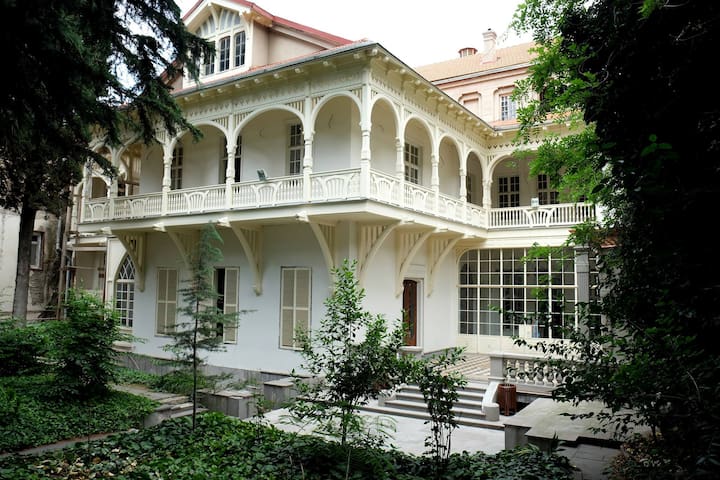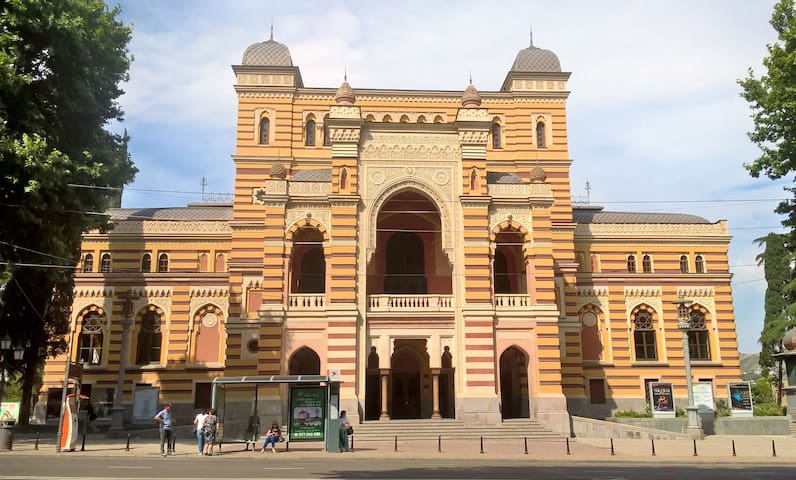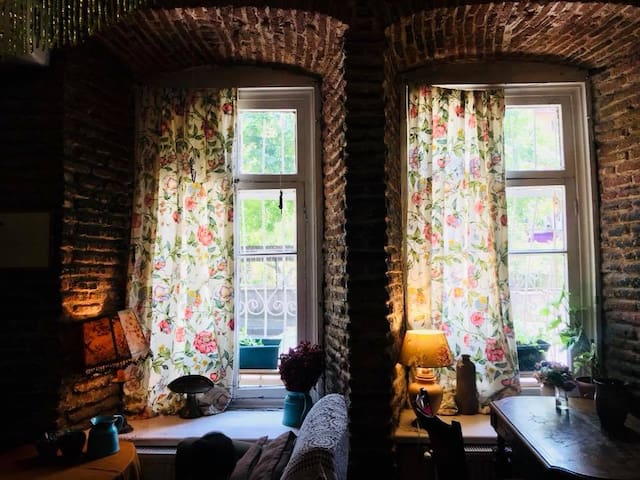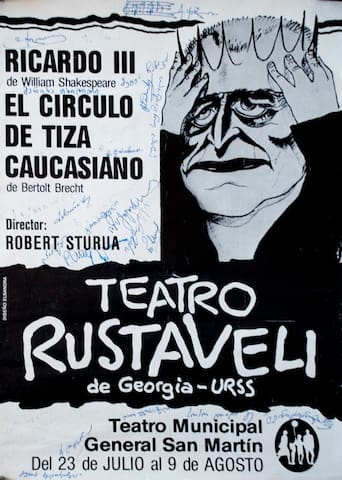Sightseeing
The mansion, Writers’ House of Georgia is presently located was built in 1903-1905 by David Sarajishvili. David Sarajishvili (1848-1911) was a famous philanthropist, founder of Georgian brandy production, Doctor of chemistry and philosophy. The building was constructed by a German architect Carl Zaar, in collaboration with architects Tbilisi Aleksander Ozerov and Korneli Tatishev; the author of exquisite wooden interior was the Georgian craftsman Ilia Mamatsashvili. The building is a great example of Art Nouveau architecture and is acknowledged as a brilliant blend of Georgian and European architectural styles.
The terrace of the Sarajishvili house is designed by ceramic tiles of famous Villeroy & Boch Company. Tiles with similar forms and patterns were an extreme rarity and were produced only on special orders. Cologne Cathedral in Germany, Bolshoi Theatre of Moscow, Abbey of Einsiedeln in Switzerland – these are the buildings, tiles similar to those on the terrace of the Writers’ House can be found.
13 Ivane Machabeli St
13 Ivane Machabeli StreetThe mansion, Writers’ House of Georgia is presently located was built in 1903-1905 by David Sarajishvili. David Sarajishvili (1848-1911) was a famous philanthropist, founder of Georgian brandy production, Doctor of chemistry and philosophy. The building was constructed by a German architect Carl Zaar, in collaboration with architects Tbilisi Aleksander Ozerov and Korneli Tatishev; the author of exquisite wooden interior was the Georgian craftsman Ilia Mamatsashvili. The building is a great example of Art Nouveau architecture and is acknowledged as a brilliant blend of Georgian and European architectural styles.
The terrace of the Sarajishvili house is designed by ceramic tiles of famous Villeroy & Boch Company. Tiles with similar forms and patterns were an extreme rarity and were produced only on special orders. Cologne Cathedral in Germany, Bolshoi Theatre of Moscow, Abbey of Einsiedeln in Switzerland – these are the buildings, tiles similar to those on the terrace of the Writers’ House can be found.
The history of the Opera theatre counts more than 165 years. The foundation of the so called Caravanserai Theatre, which would seat 800 spectators, was laid down on April 15, 1847 by the initiative of the Viceroy of the Caucasus, Adjutant General, Prince Mikhail Vorontsov. The construction of the building of the Theatre, under the supervision of the Italian architect, Scudieri lasted four years.
On April 12, 1851, the first opera theater in Transcaucasia held its Grand Opening with a masked ball, attended by the high society of Tbilisi. On October 25, same year, a popular Parisian newspaper L'Illustration printed a large article by Edmond de Bares with two pictures of the interior of the theater. The author wrote, “This is the only theatre in the city, the interior of which is totally Moorish in style, and is undoubtedly one of the most elegant, beautiful and fascinating theatrical constructions, percepted by man.”
The famous French writer Alexandre Dumas, who visited Tbilisi in 1858, dedicated a whole chapter to the Opera theatre in his book: “I must confess that as soon as I entered the lobby I was astonished by the simple and refined style of the ornament. I had a feeling as I entered the lobby of the Pompey Theatre. In the upper foyer the ornament was changed by Arabic carving. We entered the hall, which seemed to be the palace of fairies, not because of its rich decorations, but because of the fact that it was made with the most delicate taste. It is possible that much money was not spent on it, but I can say without hesitation that I, in my entire life, have never seen such a delightful hall..."
303 lokal ang nagrerekomenda
Opera at Ballet Theatre ng Tbilisi
25 Shota Rustaveli AveThe history of the Opera theatre counts more than 165 years. The foundation of the so called Caravanserai Theatre, which would seat 800 spectators, was laid down on April 15, 1847 by the initiative of the Viceroy of the Caucasus, Adjutant General, Prince Mikhail Vorontsov. The construction of the building of the Theatre, under the supervision of the Italian architect, Scudieri lasted four years.
On April 12, 1851, the first opera theater in Transcaucasia held its Grand Opening with a masked ball, attended by the high society of Tbilisi. On October 25, same year, a popular Parisian newspaper L'Illustration printed a large article by Edmond de Bares with two pictures of the interior of the theater. The author wrote, “This is the only theatre in the city, the interior of which is totally Moorish in style, and is undoubtedly one of the most elegant, beautiful and fascinating theatrical constructions, percepted by man.”
The famous French writer Alexandre Dumas, who visited Tbilisi in 1858, dedicated a whole chapter to the Opera theatre in his book: “I must confess that as soon as I entered the lobby I was astonished by the simple and refined style of the ornament. I had a feeling as I entered the lobby of the Pompey Theatre. In the upper foyer the ornament was changed by Arabic carving. We entered the hall, which seemed to be the palace of fairies, not because of its rich decorations, but because of the fact that it was made with the most delicate taste. It is possible that much money was not spent on it, but I can say without hesitation that I, in my entire life, have never seen such a delightful hall..."
Neighborhoods
4 Ingorokva Street
4 Ingorokva StreetA very authentic interior design.
The Rustaveli State Drama Theatre name is revered in Georgia and abroad. Long associated with high artistry and serious theatre, its talented actors and pioneering producers together continue to collaborate on inquisitive, inspiring, and modern productions. Outside of Georgia, it is often called “The Theatre of Stars” in honour of its actors’ gifts. Distinguished by its youthful vigour and constant quest for new theatrical directions and forms, for more than a century the Rustaveli has been the epicenter for Georgian national expression. Then and now, the theater's ethos has always been to stage work that is socially engaged and profoundly creative. The Rustaveli Theatre was founded in 1879 by a special dramatic committee made up of famous Georgian actors and writers along with cultural and political figures. Since that time the theatre has had a romantic but sometimes trying history. Shortly after the theatre’s foundation in 1882, David Eristavi’s play The Homeland was performed in a production that soon became a national event. Witnessing a play where the set decoration included national flags, and where Georgians celebrated the glory of their indepent past while speaking their native language, spectators began to make spontaneous peaceful demonstrations mid-performance. It also became a great cause for concern in the eyes of the Russian imperial government, and so almost immediately after its inception the Rustaveli was at the centre of current affairs. One of the key figures of the theatre’s past is the political playwright Kote Marjanishvili, whose plays championed social reform. Akhmeteli, another luminary in the history of the theatre and a celebrated pioneer of conceptual directing, directed his script Fuente Ovejuna (1922), Antonov’s Sun Eclipse in Georgia (1923), and Hamlet (1925) with a light but incisive style that was firmly grounded in the Georgian national character. Akhmeteli’s dazzling productions were distinguished by a sense of civic consciousness, restraint, and by his own exacting nature. His most renowned shows are Lavrev’s Disorganization (1928), Shanshiashvili’s Anzori (1928), Robakidze’s Lamara (1930), and Dadiani’s Tetnuldi (1931). The Soviets later executed Akhmeteli as a nationalist and enemy of the people in 1936. At that time they also executed, punished, or exiled a number of actors and other theater employees.
320 lokal ang nagrerekomenda
Teatro ng Rustaveli
17 Shota Rustaveli AveThe Rustaveli State Drama Theatre name is revered in Georgia and abroad. Long associated with high artistry and serious theatre, its talented actors and pioneering producers together continue to collaborate on inquisitive, inspiring, and modern productions. Outside of Georgia, it is often called “The Theatre of Stars” in honour of its actors’ gifts. Distinguished by its youthful vigour and constant quest for new theatrical directions and forms, for more than a century the Rustaveli has been the epicenter for Georgian national expression. Then and now, the theater's ethos has always been to stage work that is socially engaged and profoundly creative. The Rustaveli Theatre was founded in 1879 by a special dramatic committee made up of famous Georgian actors and writers along with cultural and political figures. Since that time the theatre has had a romantic but sometimes trying history. Shortly after the theatre’s foundation in 1882, David Eristavi’s play The Homeland was performed in a production that soon became a national event. Witnessing a play where the set decoration included national flags, and where Georgians celebrated the glory of their indepent past while speaking their native language, spectators began to make spontaneous peaceful demonstrations mid-performance. It also became a great cause for concern in the eyes of the Russian imperial government, and so almost immediately after its inception the Rustaveli was at the centre of current affairs. One of the key figures of the theatre’s past is the political playwright Kote Marjanishvili, whose plays championed social reform. Akhmeteli, another luminary in the history of the theatre and a celebrated pioneer of conceptual directing, directed his script Fuente Ovejuna (1922), Antonov’s Sun Eclipse in Georgia (1923), and Hamlet (1925) with a light but incisive style that was firmly grounded in the Georgian national character. Akhmeteli’s dazzling productions were distinguished by a sense of civic consciousness, restraint, and by his own exacting nature. His most renowned shows are Lavrev’s Disorganization (1928), Shanshiashvili’s Anzori (1928), Robakidze’s Lamara (1930), and Dadiani’s Tetnuldi (1931). The Soviets later executed Akhmeteli as a nationalist and enemy of the people in 1936. At that time they also executed, punished, or exiled a number of actors and other theater employees.
Elle porte le nom du voyageur et l’écrivain français Jean Chardin qui a fait un long périple en Orient qui l’a mené notamment en Géorgie.
Улица носит имя французского путешественника и писателя Жана Шардена, совершившего в XVII веке длительное путешествие на Восток и, в частности, в Грузию. В 1672 году он посетил Тбилиси и оставил описание города.
62 lokal ang nagrerekomenda
Jan Shardeni Street
Jan Shardeni StreetElle porte le nom du voyageur et l’écrivain français Jean Chardin qui a fait un long périple en Orient qui l’a mené notamment en Géorgie.
Улица носит имя французского путешественника и писателя Жана Шардена, совершившего в XVII веке длительное путешествие на Восток и, в частности, в Грузию. В 1672 году он посетил Тбилиси и оставил описание города.
Sioni Street
Sioni StreetIn the heart of Old Tbilisi, Cafe in the garden of Writers house. Exquisite European cuisine with a touch of Modern Georgian dishes.
Ivane Machabeli Street
Ivane Machabeli StreetIn the heart of Old Tbilisi, Cafe in the garden of Writers house. Exquisite European cuisine with a touch of Modern Georgian dishes.







